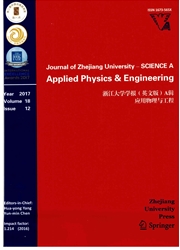

 中文摘要:
中文摘要:
在象水泥和岩石那样的伪易碎的材料和象金属和合金那样的可锻的材料的破裂进程的充分自动的有限元素(FE ) 建模,具有在估计结构的完整的大意义并且介绍巨大的挑战给设计社区。一挑战躺在一个目的和有效裂缝繁殖标准的采纳。这篇论文基于能源节约和连贯的地区模型(CZM ) 的原则建议一个裂缝繁殖标准。虚拟裂缝延期技术被用来在标准计算微分术语。充分自动的分离裂缝建模方法论,集成发达标准,为裂缝建模的 CZM ,提供裂缝繁殖的一个简单重新协调的过程,在增长粘性框架以内实现为可锻的材料建模的 J2 流动理论,和一个本地弧长度解答者到非线性的方程系统,在一个内部程序被开发并且实现。三个例子,即,与一个单身者一起的一根平凡具体横梁砍快克,有多重裂缝的一根钢筋混凝土(RC ) 横梁和一个紧缩紧张的钢标本,被模仿。在数字预言和实验数据之间的好同意被发现,它表明标准的适用性到伪易碎、可锻的材料。
 英文摘要:
英文摘要:
Fully automatic finite element (FE) modelling of the fracture process in quasi-brittle materials such as concrete and rocks and ductile materials such as metals and alloys, is of great significance in assessing structural integrity and presents tremendous challenges to the engineering community. One challenge lies in the adoption of an objective and effective crack propagation criterion. This paper proposes a crack propagation criterion based on the principle of energy conservation and the cohesive zone model (CZM). The virtual crack extension technique is used to calculate the differential terms in the criterion. A fully-automatic discrete crack modelling methodology, integrating the developed criterion, the CZM to model the crack, a simple remeshing procedure to accommodate crack propagation, the J2 flow theory implemented within the incremental plasticity framework to model the ductile materials, and a local arc-length solver to the nonlinear equation system, is developed and implemented in an in-house program. Three examples, i.e., a plain concrete beam with a single shear crack, a reinforced concrete (RC) beam with multiple cracks and a compact-tension steel specimen, are simulated. Good agreement between numerical predictions and experimental data is found, which demonstrates the applicability of the criterion to both quasi-brittle and ductile materials.
 同期刊论文项目
同期刊论文项目
 同项目期刊论文
同项目期刊论文
 Towards fully automatic modelling of fracture process in quasi-brittle and ductile materials: a unif
Towards fully automatic modelling of fracture process in quasi-brittle and ductile materials: a unif Fully automatic modelling of mixed-mode crack propagation using scaled boundary finite element metho
Fully automatic modelling of mixed-mode crack propagation using scaled boundary finite element metho 期刊信息
期刊信息
